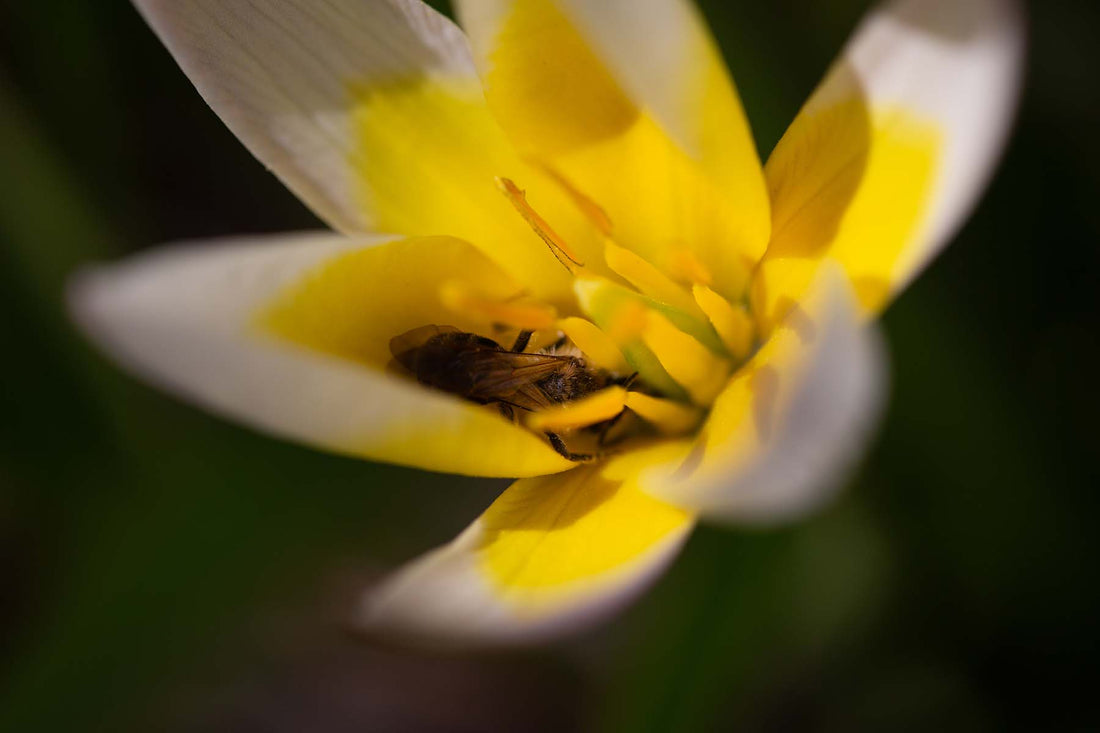Pollinators are in trouble. You may have heard about the plight of global honeybee populations. But bees aren’t the only pollinators encountering difficult conditions like habitat destruction and widespread pesticide usage — insect, bird, and other pollinator populations are also suffering. Thankfully, their decline isn’t a done deal. Here’s what the world’s pollinators are up against and how individuals and communities can better stack the odds in their favour.
What is a pollinator and what do they do?
While some plants reproduce asexually by cloning themselves, many of the foods humans eat depend on plants that reproduce sexually. These plants have a female part (the stigma) that requires fertilization by pollen from their male part (the anther) to create offspring.
To facilitate sexual reproduction, plants employ a couple of different strategies. One method is by releasing huge amounts of tiny pollen grains. These grains are then carried by the wind and some of them ultimately make their way to the stigmas of other plants where fertilization takes place.
Other plants, meanwhile, have evolved to attract pollinators as their agents of reproduction. To do this, they produce nectar — an irresistibly sweet food that’s also a great source of energy.
As the pollinator lands on the flower to drink the nectar, pollen from the anther (the male part of the flower) transfers to their body. And, when they move on to the next flower, some of those grains fall off, fertilizing the stigma (the female portion) of the flower.
Any creature that’s involved in this second method of fertilization is considered a pollinator. Honey bees are probably the most famous, but other animals including various species of bees, wasps, flies, butterflies, birds, moths, beetles, bats, and mosquitoes also fill this role.

How pollinators affect our lives
Pollinators are indisputably crucial to our food system. In fact, their efforts are thought to be responsible for 30% of global food production — a staggering proportion of our diet.
In Canada, bees alone were responsible for an estimated $3.18 billion in value in 2021. And their benefit isn’t limited to plants that reproduce sexually. Crops like canola and some coffee varieties experience an increase both in the quality and the quantity of their output when they’re visited by pollinators, despite being considered wind-pollinated species. In other words, growers couldn’t harvest the range of foods they do without the help of pollinators.
Pollinators don’t just help us eat better. Agriculture accounts for hundreds of thousands of Canadian jobs, from the farmers who grow and sell produce, to the companies that process the food and transport it to the grocery stores that sell the final product.
Moreover, pollinators play a crucial role in the ecosystems they inhabit. Through pollination, they help spur the reproduction of crucial nutritional sources for other creatures. What’s more, many of them, such as mosquitoes, serve as food themselves.
Without pollinators, the health of both your local ecosystem and economy would be significantly weaker.
What’s happening to pollinators?
The last decades have seen a record drop in the world’s insect population — an incredible 76% decline over the last 27 years. If you imagine the disappearing insects as being exclusively mosquitoes, insectageddon might not seem like a bad thing. However, even removing pesky bugs from the ecosystem isn’t beneficial.
Mosquitoes may be famous bloodsuckers, but only the female members of the species bite humans. Male mosquitoes consume nectar instead, which makes them important pollinators for a variety of plants. And, both genders function as a food source for larger animals like bats, frogs, birds, dragonflies, and fish.
Insects aren’t the only pollinators at risk. A 2022 report notes that 3 billion birds have disappeared from Europe and North America over the past 50 years. Also noteworthy — bats, who often have an important role to play in pollination as well, are considered endangered in many parts of the world.
Why are pollinators disappearing?
So why are pollinators disappearing? The most obvious reason is the wide-scale use of what’s known as agrochemicals, which include insecticides, pesticides, and fertilizers.
For example, neonicotinoids, or neonics, are the most widely used insecticide worldwide. They’re applied to crops like wheat, corn, canola, and soy to protect them from insect pests. Unfortunately, their effects aren’t confined to just the pests. Neonics are highly toxic to beneficial insects like bees and butterflies, as well as birds and amphibians.
Even low-level exposure to these pesticides is harmful. In bees, it influences their neuronal function, causing seizures and impacting the way they learn. This, in turn, affects their ability to navigate and reproduce.
Herbicides, which are intended to kill weeds, are another problematic class of chemical since they’re also toxic to birds, fish, insects, and beneficial soil microorganisms.
Even fertilizers may prove problematic, since they disrupt the electrical fields of flowers. This disturbs the typical sensory experience for pollinators, and dissuades them from visiting the plants.
As a result, the agrochemicals meant to protect and nourish plants, end up injuring the very plants they’re supposed to be helping.
But the blame doesn’t lie with agrochemicals alone. As climate change spurs extreme weather events and shifts in seasonal norms, pollinators have a harder time finding food, knowing when to migrate, and dealing with increasingly extreme temperatures.
Furthermore, as urban centres spread and wilderness is converted to agricultural land, the wild plants and flowers pollinators rely on are lost. Bees can travel as far as 12km to find food, but they prefer to visit flowers much closer to their hive. If their immediate surroundings are asphalt roads and concrete towers, it’s very difficult for them to find the nutritional resources they need to survive.
How farming contributes to pollinator decline
Many modern farming practices are detrimental to pollinator health even above and beyond their land use and chemical issues. For starters, modern agriculture often favours industrial monoculture farming. These single-crop farms operate on massive scales, attracting large numbers of pollinators, like bees, all at once.
This may sound like a feast for pollinators, but it’s also a great way for viruses and other pathogens to spread. Think of it as a massive festival with shared food — just a couple cases of illness in a few of the attendees can cause an outbreak. As the bees flit from flower to flower, the potential for them to encounter a virus or a parasite shared by a fellow pollinator increases.
Moreover, bees and other pollinators often require pollen sources from a variety of different flowers. While they can live on single sources of pollen, these don’t usually provide the full collection of nutrients they need. For example, dandelion flowers are low in valine, isoleucine, leucine, and arginine, which are crucial amino acids for bees. Dandelion flowers may be helpful for bees in a pinch, but bees who dine exclusively on their pollen become nutrient deficient over time.
In this nutrient-deficient state, pollinators are less able to fight off any pathogens or parasites they encounter.
How you can help pollinators
The problems facing pollinators may seem intractable, but the opposite is true. Research backs up what you likely already know intuitively: a thriving ecosystem depends on biodiversity. And, it’s been shown that even small changes, like planting swathes of wildflowers around a monoculture farm can help to reduce the spread of disease in bees at that site. If you’re looking to help the pollinators this season, here’s some food for thought.
1. Don’t support pesticide or insecticide use
You can do this directly by avoiding these substances in your own garden. If you’re having trouble with pests, consider using a spritz of soap and water, or look at companion planting as a way to contain the problem.
Where you spend your money makes a difference too. Organic and greenhouse-grown foods don’t rely on pesticides and insecticides the way traditional farming practices do. Buying organic or greenhouse-grown fruits and veggies directly supports growers who practice good environmental stewardship — and, it’s healthier for your family too.
Buying organic doesn’t have to stop at food. Cotton is responsible for 6.8% of the herbicides and 16% of the insecticides used worldwide. Consider shopping for certified organic cotton clothing whenever possible to avoid supporting one of the most heavily sprayed crops in the world.
2. Make your garden an oasis for local and transitory pollinators
This may sound like a big undertaking, but you can help to attract, house, and feed beneficial pollinators with just a few well-thought-out additions. For starters, consider growing a pollinator-friendly garden with a variety of native plants. There are a number of native plant suppliers across the country who can help further this aim.
Focus on planting early-sprouting flowers and berrying shrubs to ensure your garden provides for both the first pollinators of the season and for over-wintering birds.
In addition, don’t be afraid to ease up on your garden cleanup. Strategically-placed piles of dead organic matter like fallen leaves can provide a home for overwintering or reproducing insects.

3. Build a pollinator-friendly community
Notice a patch of grass collecting garbage at your local school, faith group, or grocery store? Talk to them about transforming it into a pollinator haven with a few packets of seeds and some regular watering. Many municipalities also offer funding opportunities for these projects, making them more accessible for local, non-profit community groups.
Here in King Township, we’re fortunate to live in a municipality committed to long-term support for our pollinators and environmental initiatives. King received Bee City Certification, which further complements its Integrated Community Sustainability Plan.
4. Provide strategic water sources
According to the David Suzuki Foundation, bees and other insects can’t land in open water as it puts them at risk of drowning or becoming a fish or turtle’s supper.
If you have access to outdoor space, consider leaving out a shallow dish of water for your local pollinators. If it’s on the deeper side, position a couple of rocks to stick out of the water so insects have a way to climb out. Replace every two to three days, and voilà, some much-needed refreshment for those helpful critters.
5. Support local honey producers
More than anyone, your local honey producer is committed to bolstering the health of pollinator populations. Support them by buying local, small-batch, Canadian-made honey. This will ensure you’re consuming a delicious, good-for-you product, while simultaneously funding producers who embrace sustainable environmental practices.

